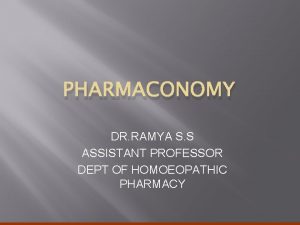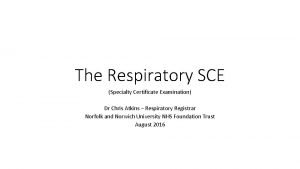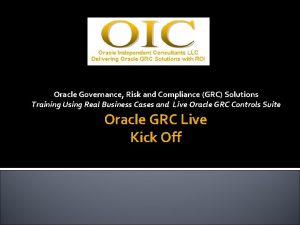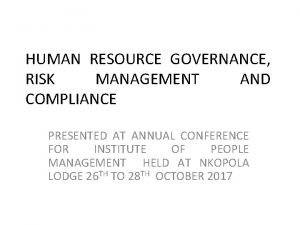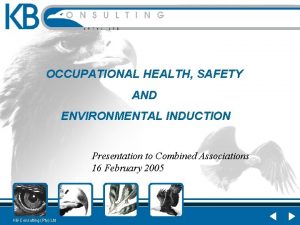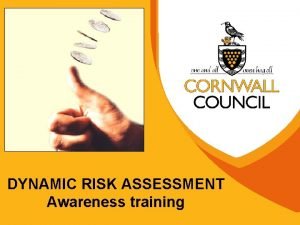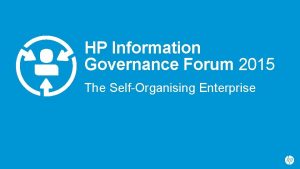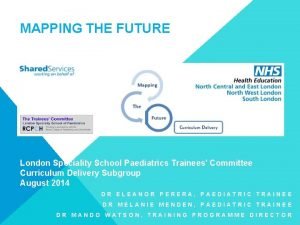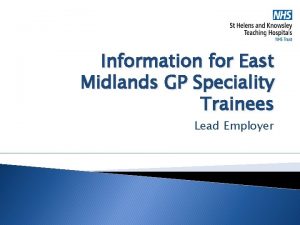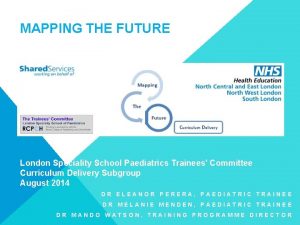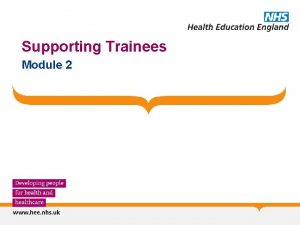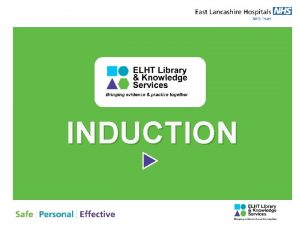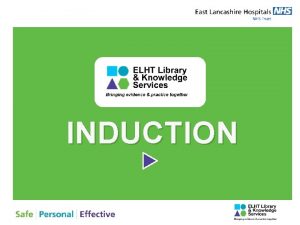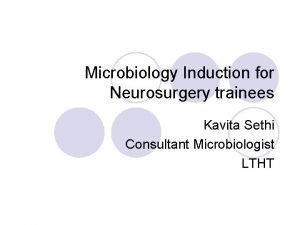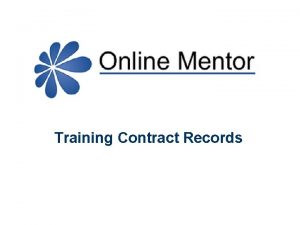Governance and Risk Management Speciality Trainees Induction Training






















- Slides: 22

Governance and Risk Management Speciality Trainees Induction Training Liane Moorhouse Clinical Risk Manager People Centred Positive Compassion Excellence

Content of Presentation • Overview of Governance and Risk Management • Identify the areas that come under Clinical Governance • Discuss Risk and Incident Reporting • Look at how Complaints and Claims link into incidents • A brief overview of record keeping • What is Consent? • Emergency Planning People Centred Positive Compassion Excellence

Governance People Centred Positive Compassion Excellence

Governance • Clinical Effectiveness – Audit, Clinical Improvement, Tissue Viability, E Rostering • Users Views – Patient Satisfaction Surveys, Friends and Family Surveys, Patient Feedback forms, talking to service users about their experience. • Risk Management – mitigating risks to ensure patient safety, staff safety, security, incident reporting, risk assessments, claims etc. • Education and Learning Effectiveness – Induction, medical, mandatory and local training of staff. People Centred Positive Compassion Excellence

Governance • Communication – effective communication up / down and across all levels of the organisation and with patients/carers and their families. • Resource Effectiveness – Buildings, equipment, staffing and financial resources. • Continuous Quality Improvement – R&D, new models of care, improved care pathways. • Information Governance – promoting the effective and appropriate use of information. People Centred Positive Compassion Excellence

Who’s responsibility is it to Manage Risk? People Centred Positive Compassion Excellence

Risk Assessment • Identify the hazards. • Decide who can be harmed and how. • Identify what controls are already in place and what further controls are required to make the task safer. Examples of risks for patients • Pressure area. • VTE. • Falls. People Centred Positive Compassion Excellence

Incidents • • 20, 000 incidents were reported in 2016/17 Highest cause groups Falls Documentation Clinical assessment Skin tissue damage Medication Errors Missed or incorrect diagnosis Inappropriate treatment People Centred Positive Compassion Excellence

Why Report? • • Legal requirement Targets and systems failures rather than staff. Identifies trends and underlying causes. Provides solutions. Informs education and training. Provides regional and national lessons learned. Promotes efficiency and quality. Develops models of good practice. People Centred Positive Compassion Excellence

Triggers for Incidents • • Unexpected injury or death Sharps incidents Violence and Aggression Security Incidents Lost property Equipment failure Patient Absconding Poor management of confidential information People Centred Positive Compassion Excellence

SERIOUS UNTOWARD INCIDENTS A Serious Untoward Incident or SUI is identified as follows: • Unexpected or Avoidable Death • Serious Harm • Adverse Medication Error • Never Event – such as wrong site surgery • Abuse allegations • Organisational ability to deliver healthcare services People Centred Positive Compassion Excellence

BEING OPEN – DUTY OF CANDOUR For all level 3 and above incidents involving moderate to severe harm, staff must adhere to the Duty of Candour Regulation 20: – Notify the patient (or person lawfully acting on their behalf) in person that the incident has occurred and apologise – Provide a true account of all the facts known about the incident – Advise the patient of what further enquiries into the incident are appropriate – Provide reasonable support to the patient – Make a written record of the meeting and keep it securely. – Follow up with a written notification confirming information provided, the details and results of further enquiries and an apology People Centred Positive Compassion Excellence

People Centred Positive Compassion Excellence

Incident Reporting Homepage User ID needs to be surname, initial then number 1 Example: User ID: bloggsj 1 Password: same as BFW login People Centred Positive Compassion Excellence 14

Complaints and Claims • Incidents can lead to complaints and claims. • A complaint is “An expression of dissatisfaction that requires response”. • A claim is defined as an allegation of clinical negligence and/or demand for compensation. Claims are received following an adverse clinical incident or adverse incident resulting in personal injury. Any claim following a clinical incident carries significant risk of litigation for the Trust. People Centred Positive Compassion Excellence

Complaints and Claims • Informal complaints should be handled by the Department/Division in which the incident occurs or through the Patient Advisory Liaison Service (PALS). • Formal complaints are directed to the Chief Executive to manage through the Complaints Procedure of the Trust. • Claims are handled by the Claims Department in accordance with the Civil Procedure Rules, which are the court rules by which civil litigation are governed. • A claimant has to prove both breach of duty and causation before they are eligible to receive compensation. • The Trust has a being open policy. People Centred Positive Compassion Excellence

Record Keeping • • Maintain records that are fit for purpose. Black Ink. Signed. Clear and legible. Signed, dated, designation. In real time. No correction fluid. People Centred Positive Compassion Excellence

Consent • Consent is a patient’s agreement for a health professional to provide care. • Patients may indicate consent non verbally (presenting their arm for their pulse to be taken), orally, or in writing. • For consent to be valid, the patient must: – Be competent to make that decision – Have received sufficient information to make a decision – Not be acting under duress. People Centred Positive Compassion Excellence

Consent • Before you examine, treat or care for competent adult patients you must obtain their consent. • Adults are always assumed to be competent unless demonstrated otherwise. • Patients may be competent to make some healthcare decisions, but not competent to make others. • Giving and obtaining consent is usually a process, not a one off event. Patients can change their minds and withdraw consent at any time. If in doubt, always check that the patient still consents to your care/treatment. People Centred Positive Compassion Excellence

Consent Can Children give consent for themselves? • Before examining, treating or caring for a child, you must seek consent. • Young people aged 16 and 17 are presumed to have the competence to give consent for themselves. • Younger children who fully understand what is involved in the proposed procedure can also give consent (although their parents will ideally be involved). • In other cases, someone with parental responsibility must give consent on the child’s behalf, unless they cannot be reached in an emergency. People Centred Positive Compassion Excellence

People Centred Positive Compassion Excellence

Any Questions ? People Centred Positive Compassion Excellence
 Enepidermic route
Enepidermic route Sce respiratory
Sce respiratory Tata letak layout toko
Tata letak layout toko Spine layout adalah
Spine layout adalah Prince william county specialty programs
Prince william county specialty programs My future profession programmer presentation
My future profession programmer presentation Mrcp uk speciality certificate
Mrcp uk speciality certificate Data governance and risk management
Data governance and risk management Dynamics 365 risk management
Dynamics 365 risk management Credit risk market risk operational risk
Credit risk market risk operational risk Oracle grc
Oracle grc Hr governance risk and compliance
Hr governance risk and compliance Key risk indicators template
Key risk indicators template Risk map risk management
Risk map risk management Governance risk compliance framework
Governance risk compliance framework Induction training topics
Induction training topics Environmental induction training ppt
Environmental induction training ppt Risk management awareness training
Risk management awareness training Hpe information management and governance
Hpe information management and governance Forrester wave privileged identity management 2016
Forrester wave privileged identity management 2016 Higher certificate in local governance and management
Higher certificate in local governance and management Governance leadership and management
Governance leadership and management Residual risk and secondary risk pmp
Residual risk and secondary risk pmp
